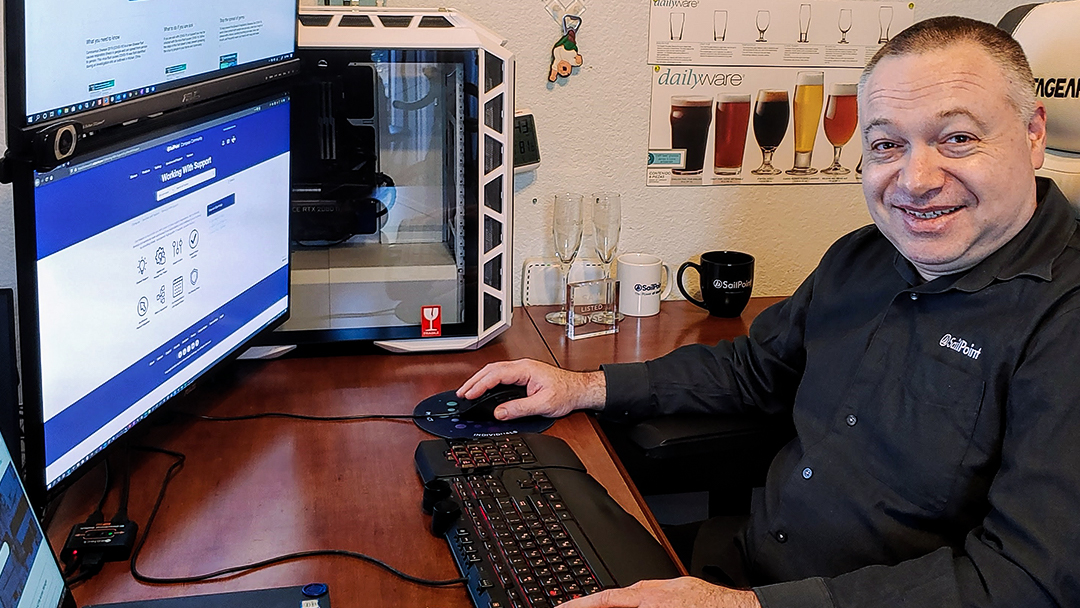Editor’s Note: Here at Smartsheet, our customers inspire us every day. This guest article comes from Igal Dar, who works as a technologies and operations manager, global support, for SailPoint, a company that specializes enterprise-level identity access management software.
Reflecting back on my career makes me feel prehistoric. I’ve worked in IT and support for over 20 years, and I’ve seen seismic shifts in how internal customers use technology and how IT professionals impact the business.
While I don’t want to generalize the role of IT functions within business, it’s become clear that there is a tangible opportunity for us to help steer business priorities by investing in and implementing the right technologies to help our workforce excel.
At the very beginning of my career I worked in IT for a tiny startup in a quality assurance role, eventually transitioning into support as the company grew and grew. What drew me to this line of work? I deeply enjoy finding creative solutions to complex problems.
Every challenge is an opportunity to find a solution, from finding the right software-as-a-service (SaaS) platform to fix an inconsistent process, or troubleshooting technical issues for SailPoint employees. It’s like working on a never-ending jigsaw puzzle: Sometimes pieces that look like they should fit don’t, so you keep trying until you find the right piece.
Advocating for IT and customers
As a technologies and operations manager in charge of global support at SailPoint, I identify technology gaps, find creative ways to make use of the tools we already have, and make recommendations for what we need.
I advocate for both the IT department and external customers, which empowers me to focus on innovation and bringing cutting-edge technology—like the Smartsheet platform—in-house. I work to find solutions that are mutually beneficial that fit with everyone’s existing business processes.
SailPoint has over 1,200 employees, and there are around 40 people working within our IT department; we have teams that focus on help desk and ticketing, desktop support, cloud, and security. Suffice to say, like most IT departments, ours has many nuanced layers and integral functions that help keep the business running as smooth as possible.
In my hybrid role, I serve technical teams and translate the needs of our internal business partners (and vise versa), as well as extend support to our customers. I’m all about eliminating tech-speak and unnecessary complexity from conversations and meeting both groups of stakeholders and customers where they are.
Having said that, it takes a lot of negotiation and people skills to do my job. This means that I have to effectively collaborate and gain the trust of colleagues across the board. When you walk the line between IT projects, and customer and employee needs—in a business-led IT environment—you have to be careful not to upset the apple cart. When working cross-functionally, I learn who owns which business process and how a technology solution would impact it.
Related Content
How to lead IT during the COVID-19 crisis
I’m a firm believer in continuous improvement, as what works today might not work in two years. Nothing we do is set in stone. If you’re stubborn about a particular process and think your way is the right way without listening to different perspectives and gathering feedback from stakeholders, you’ll end up falling behind in terms of process, technology, and how both are implemented to improve the organization.
To be a business solution manager, you also need a lot of technical know-how. You need to understand which technologies—tools, hardware, software integrations, and platforms—are on the leading edge and how your company can implement them, all without breaking the bank.
Innovation moves us forward during uncertainty
I complete weekly reports after analyzing real-time data and present these findings to our executive team. When it became evident that the COVID-19 pandemic could impact businesses, I pulled together a report on support tickets. The goal was two-fold: I wanted to anticipate if there would be an increase in requests that might overwhelm our team, then provide those findings to our executive leadership.
Even before the crisis, many of our employees worked remotely and connected to various online systems via virtual private network (VPN). Instead of seeing a spike in tickets, the numbers plateaued. Our rate of ticket closures was pretty much the same as well, despite more folks moving from on-premise to working from home.
Related Content
Obsessed with innovation: Our quest for better same-day service
We met with our director to examine our business continuity plan (BCP), which I had originally written a couple of years prior. In subsequent years, our department underwent a digital transformation—and in some ways, we still are—so we wanted to adjust our plan to make sure we were prepared.
While we use another SaaS provider for support ticketing, we sat down to answer the age-old question: “What happens if our primary ticketing system goes down?”
Within Smartsheet, it took less than 15 minutes to build a form that feeds a color-coded sheet, then replicates all of the questions that we ask our customers to fill out when they submit a request. We gave this new process to our community team and let them know that if anything happens to our current ticketing system, we’re going to flip a switch and communicate to stakeholders that we’re using Smartsheet.
Related Content
3 ways you’ll accomplish more with Smartsheet forms
During the current pandemic, it is easier to reflect a different experience in Smartsheet to customers, as support, since employees have already shifted their physical work environment, so the digital transformation of the work environment has already become the status quo. As our global support team supports external customers, partners, and enterprises, our ability to create quick solutions in Smartsheet is even more crucial. After all, our BCP has to adhere to the evolving needs and experiences of our customers.
And this doesn’t even scratch the surface for everything any team can do with the platform. It helps foster accountability through data transparency, integrates with so many essential enterprise-grade software tools, and helps me focus less on repetitive tasks and more on strategy. This underlines how our department innovates by thinking strategically about our existing systems; we know that if one system fails, you need to have a backup solution waiting in the wings.
In addition, I was really impressed with how Smartsheet, as a company, provided (seemingly overnight) customers with resources and solutions to help us handle the coronavirus pandemic. When I learned that these template sets were available via LinkedIn, I copied the new template sets into a Smartsheet workspace, then sent them to our VP of operations and our dashboard support team.
Related Content
Sharing our resources amid the coronavirus outbreak
They were extremely excited to have a brand new solution that we could use to make an immediate impact. We all know Smartsheet pretty well, which is one of the biggest wins for me when implementing a solution — the amount of confidence the business users have in a software solution.
I’ve been a Smartsheet customer for over two years, and I believe in the importance of iterative change and innovation — especially when it comes to working with IT teams, internal business partners, and advocating for customers. When we first started using the platform, we thought in terms of sheets, rows, and columns.
Today, we know it’s a platform for communication, an ad-hoc database, and a dashboard visualization tool. I’m always looking for the missing piece of a puzzle to make a process work. No matter what solution we seem to need, Smartsheet is that missing piece; we can dynamically change it to improve how we work. That’s innovation.
Learn more about how Igal and SailPoint use Smartsheet to connect their entire internal customer support experience.
And subscribe to the Smartsheet IT Newsletter for tips, strategies, and ideas focused on helping IT professionals increase their impact on their business.


